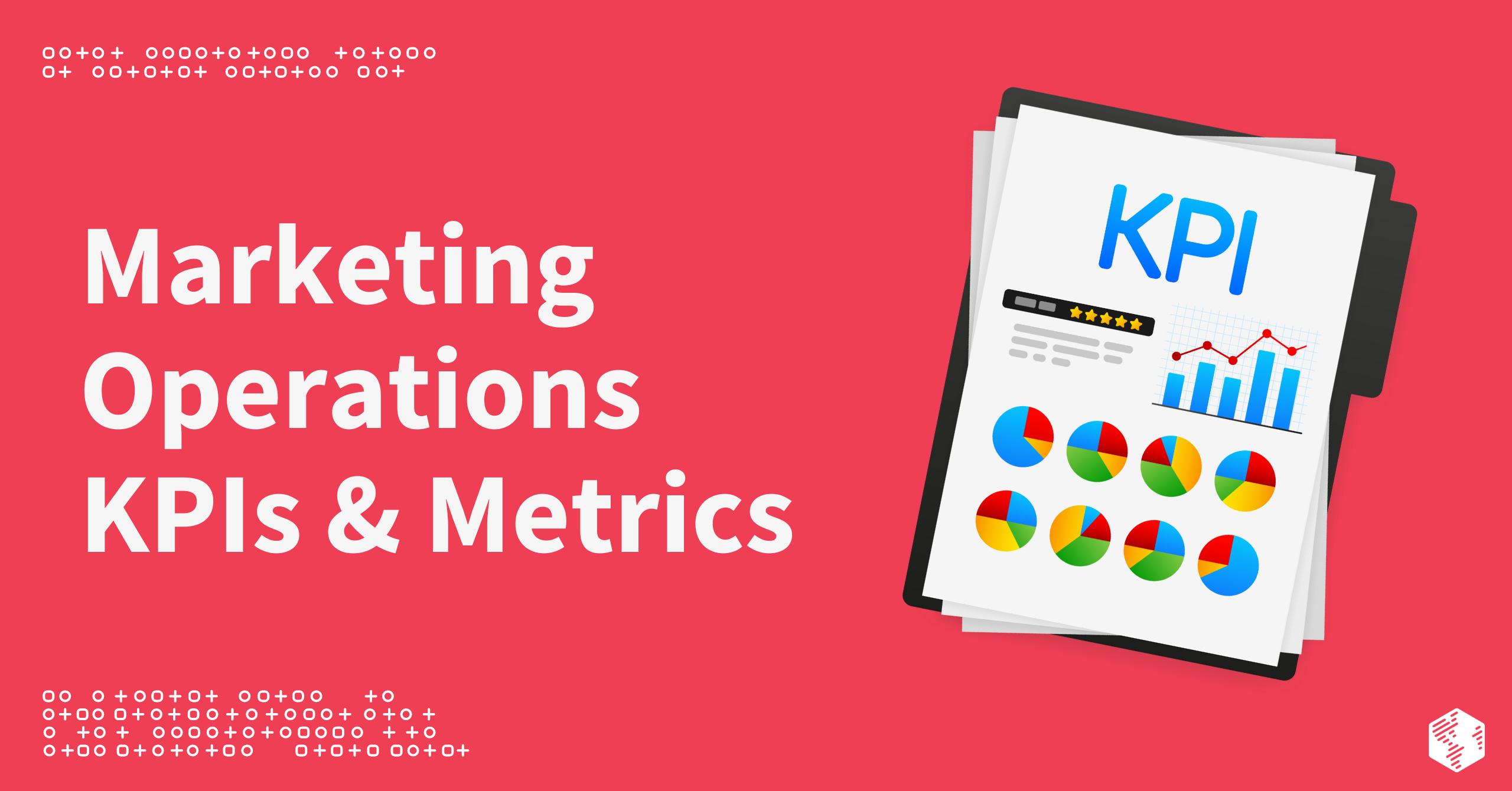Has your business-to-business (B2B) organization invested in a marketing operations (MarketingOps) initiative?
MarketingOps transforms a B2B company’s marketing efforts by ensuring your marketers operate efficiently, have what they need to succeed, and are aligned under organizational revenue goals. But these strategies rely on accurate, high-quality data your MarketingOps team can use to analyze marketing efforts, make well-informed decisions, and monitor progress toward marketing revenue goals.
The starting point is creating a standard language for collecting and organizing this valuable marketing operations data, otherwise known as key performance indicators (KPIs) and metrics. MarketingOps KPIs and metrics are numerical data that marketers and MarketingOps strategists use to take data analysis to the next level.
The Importance of KPIs & Metrics in MarketingOps
A data-driven MarketingOps strategy requires—you guessed it—lots and lots of data. But by themselves, these numbers don’t tell a comprehensible story. You need a way to organize and distill this data into manageable, bite-sized pieces that can be used to drive decision-making and analysis.
Marketing operations KPIs and metrics help B2B companies find gaps in their marketing strategy, discover trends, and gain insights into marketing performance. With real-time KPIs and metrics at their fingertips, MarketingOps professionals can determine what’s working (and what isn’t) as well as whether the marketing team’s efforts align with organizational revenue goals.
9 Key Marketing Operations KPIs & Metrics
There are endless KPIs and metrics your MarketingOps team can track, analyze, and use to construct informative reports to guide decision-making. The right marketing operations KPIs for your B2B company depends on your MarketingOps goals, mission, and strategy as well as the needs of key stakeholders. However, these nine KPIs and metrics are essential pieces to a holistic approach to marketing operations.
To measure and evaluate the success of your MarketingOps efforts, start tracking these marketing operations KPIs and metrics.
Click-Through Rate (CTR)
The click-through rate (CTR) shows the ratio of people who click on a link or call to action (CTA) to the total number of people who viewed it.
(Number of Clicks / Number of Impressions) x 100 = CTR %
CTR is a good indicator of how well your ads, headlines, images, links, CTA, and content perform for your ideal customers. A low CTR indicates you are targeting the wrong audience or using the wrong content, while a high CTR shows your marketing team has an accurate impression of what your audience wants.
Customer Acquisition Cost (CAC)
Customer acquisition (CAC) measures how much it costs to acquire a customer.
Total Cost / Number of New Customers = CAC
CAC is a time-based metric, which means your MarketingOps team will regularly calculate CAC to determine if you are spending too much money to acquire new customers and, if not, where you need to adjust the budget.
Return on Marketing Investment (ROI)
Marketing return on investment (ROI) is a measurement of the revenue generated from your organization’s marketing efforts compared to the cost of those marketing efforts. In other words, marketing ROI determines how much revenue your marketing efforts are generating vs. how much they cost to operate.
((Revenue Generated by Marketing Effort – Cost of Marketing Effort) / Cost of Marketing Effort) x 100 = Marketing ROI
Calculating return on marketing investment is an important metric, especially for justifying marketing budgets, planning future marketing strategies, evaluating the success of marketing campaigns, and demonstrating the value of MarketingOps.
Conversion Rate (CVR)
Conversion rate (CVR) calculates the percentage of people who completed a desired action when engaging with your marketing campaigns, content, website, or other channels. This action can include any number of responses, such as submitting a contact form, downloading an application, making a purchase, booking a demo, or signing up for a newsletter.
(Number of Conversions / Number of Total Visitors) x 100 = CVR %
Tracking the CVR metric helps MarketingOps strategists identify the campaigns and content that are most effective at moving customers through the marketing funnel.
Customer Lifetime Value (CLV)
Customer lifetime value (CLV), otherwise known as the lifetime value of a customer (CLV), is a measurement of how much revenue you can expect to generate from an individual customer.
Customer Value x Average Customer Lifespan = CLV
or
Average Purchase Value x Average Number of Purchases = CLV
By comparing CLV to CAC, MarketingOps leaders can determine whether marketing efforts are spending an appropriate amount of the budget on new customer acquisition—and if not, how they should adjust the marketing budget. If, for example, your B2B company’s CAC is higher than your CLV, it’s a sign that too much money is spent on acquiring customers that are not generating enough revenue.
Lead-to-Customer Conversion Rate
The lead-to-customer conversion rate KPI calculates the percentage of leads or prospects that convert into paying customers.
(Number of Converted Customers / Total Number of Leads) x 100 = Lead-to-Customer Conversion Rate
This ratio is closely related to CVR, but where CVR tracks whether leads are moving to the next stage of the marketing and sales funnel, the lead-to-customer conversion rate measures whether you are converting qualified leads into actual customers.
Bounce Rate
Bounce rate measures the percentage of website visitors who visit a webpage and then leave the site without taking any other action.
(Number of Visitors Leaving the Site After Only Viewing One Page / Total Site Visitors) x 100 = Bounce Rate
A high bounce rate indicates either visitors don’t trust your content or you have website issues like high loading time or slow page speed that encourages them to leave. A low bounce rate implies your web content is effectively reaching your ideal audience and encouraging them to take action.
By tracking the bounce rate, your MarketingOps team can determine how much your audience engages with your digital brand.
Marketing Qualified Lead (MQL) to Sales Qualified Lead (SQL) Conversion Rate
A marketing qualified lead (MQL) is a potential customer who has shown interest in your brand, products, or services through online interactions with your company but who is not ready to fully commit to making a purchase. A sales qualified lead (SQL) is a prospect who has demonstrated strong intentions to make a purchase and meets specific criteria established by your sales team, indicating they are more likely to convert.
The MQL to SQL conversion rate metric represents the effectiveness of the lead handoff and qualification process.
(Number of SQLs / Number of MQLs) x 100 = MQL to SQL Conversion Rate %
In other words, this metric measures the percentage of MQLs that convert into SQLs.
Marketing Efficiency Ratio (MER)
Marketing efficiency ratio (MER), also known as marketing efficiency rating, is a high-level view of the success of your marketing campaigns. It measures how much you have spent on marketing efforts across all channels compared to how much you have earned in marketing revenue over the same time period.
Total Revenue / Total Marketing Spend = MER
MER provides an overall view of ROI, reveals the efficiency of all marketing efforts, indicates marketing profitability, and informs MarketingOps strategists of whether the marketing team is on track to meet organizational revenue goals.
Optimize Your Marketing Performance with MarketingOps
Sustainable, predictable growth relies on strategic revenue decision-making—which, of course, relies on accurate, high-level data analysis. By tracking these key marketing operations metrics and KPIs, your B2B organization will have the high-quality data required to make data-driven decisions that drive revenue initiatives, optimize your MarketingOps efforts, and achieve your growth goals.
If you don’t have a marketing operations team that tracks these essential KPIs, now is the time to consider how MarketingOps can help you streamline your marketing efforts, create successful digital marketing campaigns, and optimize your marketing strategy from beginning to end.
You have two options: Start from scratch—which would require hiring a team of MarketingOps professionals, expanding your tech stack, and pausing progress while you reconfigure your marketing processes—or work with an established, experienced marketing operations agency like OneIMS.
If you decide to partner with us, you’ll have access to a team of marketing operations experts, our MarketingOps platforms, and personalized guidance—all stemming from our long history of working with B2B companies to build a strong marketing operations foundation.
We have a long history of working with companies in a variety of industries to develop innovative and data-driven marketing solutions. We pride ourselves on producing measurable and sustainable results.
But you don’t have to take our word for it. View testimonials from our clients and read our blog to get an idea of our training, experience, and track record of success.
Are you ready to see how marketing operations can help your B2B company grow? Schedule a consultation with us today to get started.







